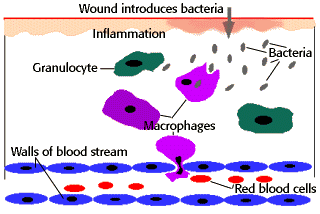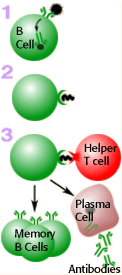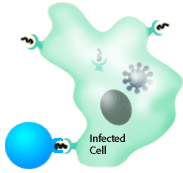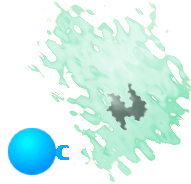Immune Response – Overview
Innate immune responseThe immune system protects the body from invading disease-causing organisms, or pathogens. Pathogens and other non-self molecules are antigens – foreign molecules recognized by the immune system, stimulating an immune response. The majority of infections by pathogens occurs in mucous membranes of our body. Innate defenses act immediately or within hours of a pathogen's appearance in the body. Innate defenses are nonspecific – they target any pathogen. Innate defenses include:
Phagocytes ("phago-"=eating, "cyte"=cell) migrate to affected areas and engulf pathogens. Neutrophils and macrophages are phagocytic white blood cells. This migration of white blood cells causes the redness and inflammation associated with infection. Some cells of innate immunity are of special importance for regulating our immune response. These cells called dendritic cells or Langerhans cells can move through out our body, and are particularly rich in our skin and mucus membranes of our body that are exposed to foreign material, including our disgestive systems, airways, and sexual apparatuses. When dendritic cells encounter foreign material, they also are phagocytic (eat the material), but have special receptors that allow them to distinguish harmless and pathogenic (disease causing) organisms. However, these cells carry fragments of pathogen to lymph nodes where they either prevent or stimulate an adaptive immune response. The decision about which response to cause depends on the foreign material (dangerous pathogens cause a dramatic response) and whether cells of your own body are sending out "danger" or distress signals. The significance of the dendritic cells is that they can prevent you from reacting against your own tissues, against food that you ingest or harmless materials from your environment, or they can tell the rest of your immune system to make an adaptive immune response.
Adaptive immune response
Microscopic movie of cytotoxic Human Immunodeficiency Virus (HIV) specifically attacks Helper
T cells. Without an adequate supply of Helper T cells, the immune
system cannot signal B cells to produce antibodies or Cytotoxic
T cells to kill infected cells. When HIV has critically depleted
the Helper T cell population, the body can no longer launch a specific
immune response and becomes susceptible to many opportunistic infections.
This immunodeficiency is described in the name acquired immunodeficiency
syndrome, or AIDS. Recent work shows that the CD4 and CCR5 membrane proteins are targets for HIV infection.
Thus, our memory cells are rapidly infected and destroyed in the mucus membranes of our tissues. We have only recently recognized that the memory cell destruction occurs in the first several days after HIV infection, suggesting that
therapies should begin as soon as the infection is recognized. |
||||||||||
Impacts | Immume response | Immunology and HIV | Treatment | Test yourself
The Biology Project
The University of Arizona
Monday, April 3, 2000
Contact the Development Team
http://www.biology.arizona.edu
All contents copyright © 2000. All rights reserved.




